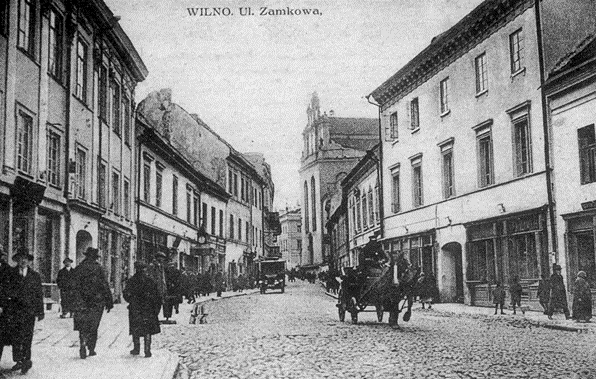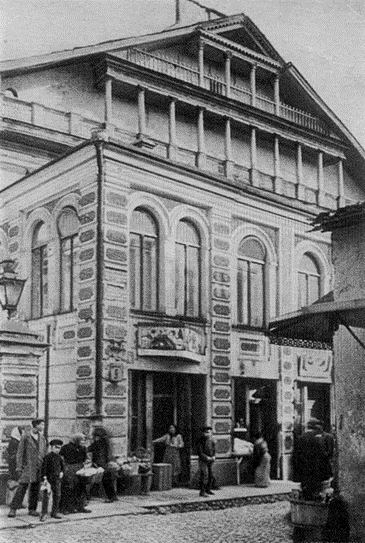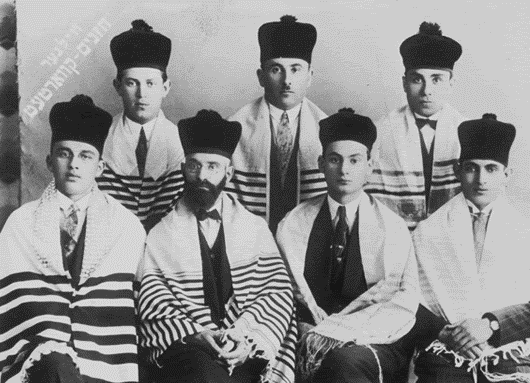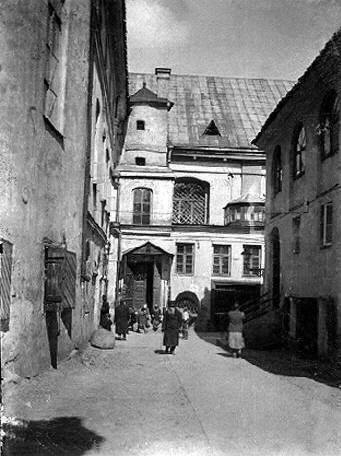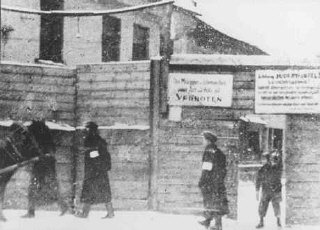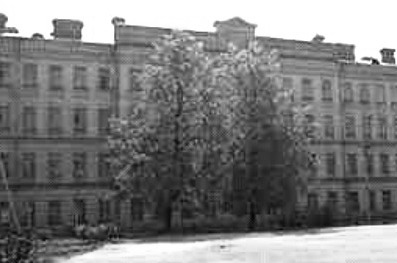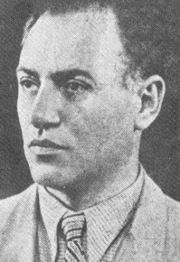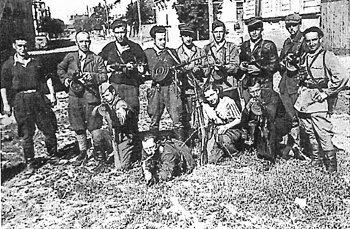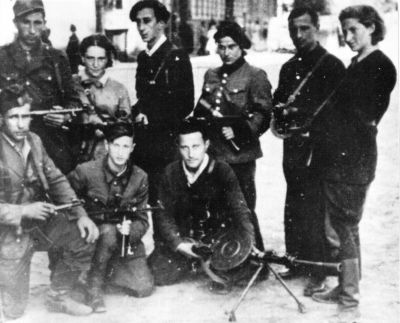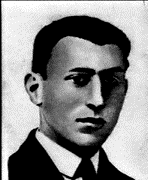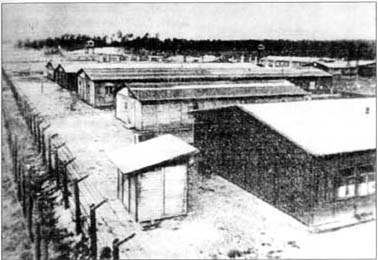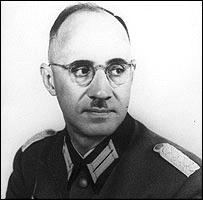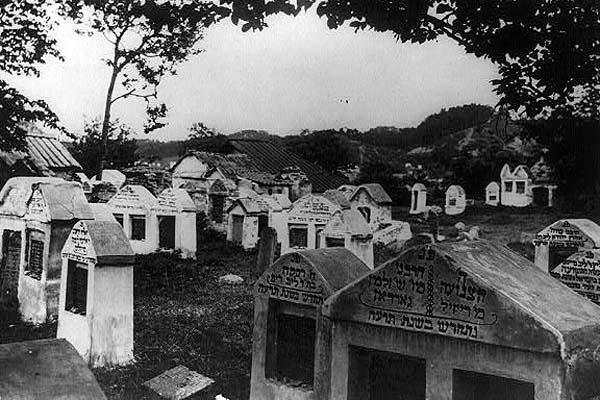Holocaust Education & Archive Research Team |
Ghettos
Introduction to the Ghettos of the Holocaust
Jewish Ghettos The Judenrat Judenrat Leaders Prominent Jews
| ||||||||||
The Vilnius Ghetto Jewish Life in Vilnius/Vilna To read more on Ponary click [here]
Jews have played a part in the history of Lithuania since the 14th century, lured to the region by tolerant Lithuanian Dukes seeking to make advancements in trade and culture. Jews first arrived as merchants, artisans, and traders, but soon evolved into an integral component of Lithuania's national identity. The very first documents mentioning Jews in Vilnius date back as early as 1567. At that time Jews did not have the right to purchase houses in the city, they could only rent them. Jews gained the right to own buildings in Vilnius only in 1593. Before that, they were allowed to reside in the lands which did not belong to the magistrate, so called jurisdiks. At the end of 16th - beginning of 17th centuries they were allowed to inhabit Zhydų (Jewish), Šv. Mykolo (Saint Michael's), and Mėsinių (Butchers') streets. They could also live on Vokietchių (German) street, but the windows of their apartments could not face the street. The Jewish quarter was formed in the Old Town. According to 1784 census there were around 5000 Jews in Vilnius at that time; according to 1897 census Jews constituted 38.8% of town's population (64.000 Jews). By the early twentieth century, half of the city's 120,000 strong population were Jews, most of whom spoke Yiddish. Vilnius became the hub of Judaic religious culture in Europe, with over 110 synagogues, 10 yeshivas, and was home to the famed Yiddish Institute of Higher Learning (YIVO) and the Strashum Library, which housed the world's largest collection of Yiddish-language books; (both were destroyed by the Nazis). The city was known as the "Jerusalem of the North" due to a high concentration of Talmudic Scholars, and historical connection to the famed Elijah ben Solomon Zalman (1720-1797) otherwise known as "The Gaon" or "Genius of Vilna" Elijah ben Solomon Zalman was the learned Rabbi who edited and commented on the Babylonian Talmud.
Anti-Semitism had been rampant in Lithuania since 1881 when a band of military conscripts attacked Jewish shops, burning and looting. Jews banded together to defend their families and property but sporadic pogroms continued throughout the region for the next 50 years.
On October 28, 1939 there was another outbreak of anti-Jewish riots in Vilnius. As rioters ransacked the city, Jewish tradesmen once again organized defense groups to oppose the attackers. However more often than not, Lithuanian policemen would beat Jewish victims rather than trying to reconvene peace. The riots lasted for three days, and followed with rumors of more anti-Semitic assaults on November 10-11, which were "traditional" dates for such events. In June 1940 Lithuania was annexed to the Soviet Union and became a Soviet Republic. At first Jews living in Vilna welcomed the Soviet troops in hope that they might be protected from the rampant anti-Semitism displayed by the Lithuanians but they were soon to feel differently as all the Zionist parties and youth organizations were disbanded and some of the members forced to join the "Comsomol" (Communist Youth Organization). The Hebrew school was closed and in its place a Yiddish school opened, Jewish businesses were nationalized and given over to Commissars' shops were closed and the supply of goods decreased resulting in crippling price inflation. The middle class, mostly Jewish, bore most of the brunt, and the standard of living dropped gradually. in June 1941 several Jewish families were exiled into Russia as "Unreliable Elements". The German Invasion
On June 22, 1941 German forces entered Vilnius and assumed control of the city meeting with little resistance. Many young Jews fled eastward hoping to avoid living under German rule, however the bulk of the Vilnius's Jewish families remained. Almost immediately, life began to change for them. On June 27, 1941 Jewish males were picked up off the streets and forced to labor for the Germans. Some were returned home at the end of the day but many were never seen again. According to (rumors) they were sent to work in "other locations". The first shootings of Jews in Vilnius were believe to have occurred on 4 July 1941, after the military administration was replaced by a civil administration. On the same date the Germans ordered the establishment of a Judenrat (Jewish Council) which was intended to control the Jewish ghetto police and various departments of: work, health service, social welfare, food, housing, etc. Of special importance was the department of work.
The Judenrat considered that as long as the Jewish workforce was of use to the Germans, the ghetto would not be liquidated. This was a kind of warranty, allowing Jews to retain some hope of continued existence and eventual survival. Almost all men and women of suitable age and fitness were employed in different factories and workshops, but were often also impressed for forced labor.
Establishment of the Ghettos
The Germans had established a ghetto in the Jewish quarter of the city. Families were evicted from their homes and imprisoned in Lukiszki between august 31 and September 2, they would all be killed and buried in mass graves at Ponary two days later. According to a German report, these Jews were executed as reparation for Jewish shooting of German soldiers. This report also indicated that 864 males, 2,019 females, and 817 children now resided within those pits.
The Germans originally created two ghettos separated by Niemiecka St. This street was outside the limits of both ghettos and served as a barrier between them. A wooden fence enclosed each ghetto, and the entrances of houses facing the outside were blocked off. Each ghetto had only one gate for exit and entry, placed at opposite ends of the ghetto so that it would be impossible for those entering and leaving to cross paths. There was no authority within the ghetto to direct incoming Jews to their new dwellings and there was not enough room for the amount of inhabitants. Many Jews found space in attics, basements, hallways, or even open yards. Ghetto No. 1 was designated for craftsmen and workers with permits, and that Ghetto No. 2 was for everyone else. This is when the transfer of orphans, the sick, and the elderly from No. 1 to No. 2 began. Those with work permits moved with their families into Ghetto No. 1. On September 15, the Ghetto police published a notice stating that those without work-permits would have to move to Ghetto No. 2 to elevate congestion. That night approximately 3, 000 people began in the direction of the second ghetto, only 600 reached its gate. The rest were taken to Lukiszki and then Ponary where they met their demise. The 600 Jews that reached the second ghetto were most likely allowed to do so in order to deceive the Jews. They had no idea what had happened, they didn't even think that the Germans had ordered the transfer, they believed it was the Ghetto No. 1 Judenrat cleaning up their ghetto. The Germans continued to deceive the Jews, telling them they were being transferred for work or some other untruth and continued the extermination process until the total liquidation of the two ghettos was complete. The Germans had successfully mislead 32,000 Jews to their own downfall. Through the rest of October 1941, the small ghetto was liquidated via a series of action designed to thin the Jewish populace of all those but skilled workers. The mass killings continued to take place till the end of 1941. With approximately 15,000 Jews left alive in the ghettos at the start of the new year. 1942 brought relative stability to the ghetto. The need to bolster the German economy through forced labor left skilled workers and their families both alive and employed in some form of occupation or another.
The dominant figure in the Ghetto leadership was Jacob Gens, the Jewish police commander. Gens' position was controversial since he participated in the deportations. Yet he saw himself as a utilitarian preserving the greatest number for the longest period of time. During the selections of October and November 1941 Gens himself checked the papers of the Jews as they passed before him, three blue cards to one yellow card. In October he participated in the Aktion that removed about 150 old and incapacitated Jews from the ghetto. In two "actions" in December he supervised the delivery of over 150 Jewish "criminals" to Ponary. In October 1942, Gens, who was also responsible for several smaller surrounding ghettos, sent his deputy to the Ozmiana Ghetto to choose 400 elderly and chronically ill people to be killed. The Germans had demanded 1,500 for transportation to Ponary. Gens believed that by helping to supervise the "actions", a proportion of those who would otherwise be killed might be saved. Justifying his "actions", Gens said:
Resistance The United Partisan Organization-Fareinikte Partisaner Organizatzie - F.P.O.- was formed on January 21, 1942 in the Vilna Ghetto. It took on the motto: "We will not allow them to take us like beasts to the slaughter." This was one of the first resistance organizations that was established in the ghettos during World War II. Unlike in other ghettos, the resistance movement in the Vilna Ghetto was not run by ghetto officials. Jacob Gens cooperated with German officials in stopping armed struggle. The FPO brought together socialist-Zionists, right-wing conservatives, communists and Bundists. It was headed by Yitzhak Wittenberg, Josef Glazman, and Abba Kovner. The goals of the FPO were to establish self-defense in the ghetto, to sabotage German industrial and military activities and to join the partisan and Red Army’s fight against the Nazis. However, the FPO did not succeed in its mission. In early 1943, the Germans caught a resistance member in the forest and the Judenrat, in response to German threats, gave Wittenberg over to the Gestapo. The FPO was able to rescue him through an armed struggle and were then able to set up a small militia. The Judenrat did not tolerate this, though, because the Nazis constantly put pressure on them to end the resistance or face liquidation. The Judenrat knew that Jews were smuggling weapons into the ghetto and when a Jew was arrested for the purchase of a revolver, they finally gave the people an ultimatum. The Judenrat turned the people against the resistance members by making them seem like selfish enemies who were provoking the Nazis. Gens emphasized the people’s responsibility for one another. He said that resistance was sacrificing the good of the community. The FPO new that having the idea to fight is one thing, but being prepared to fight is quite another. Shovels and hammers are no match to machine guns - weapons needed to be found. Weapons were an extremely hard item to attain in the ghetto. And, even harder to acquire was ammunition.
There were two main sources from which the ghetto inhabitants could obtain guns and ammunition - partisans and the Germans. And neither wanted the Jews to be armed. Slowly collecting by buying or stealing, risking their lives every day for carrying or hiding, the members of the F.P.O. were able to collect a small stash of weapons. They were hidden all over the ghetto - in walls, under ground, even under a false bottom of a water bucket. The resistance fighters were preparing to fight during the final liquidation of the Vilna Ghetto. No one knew when that was going to happen - it could be days, weeks, perhaps even months. So every day, the members of the F.P.O. practiced. One knock on a door - then two - then another single knock. That was the F.P.O.s secret password.6 They would take out the hidden weapons and learn how to hold it, how to shoot it, and how not to waste the precious ammunition.
Everyone was to fight - no one was to head for the forest until all was lost. At a meeting with the head of Vilna's Jewish council, Jacob Gens, on the night of July 15, 1943, Wittenberg was arrested. As he was taken out of the meeting, other F.P.O. members were alerted, attacked the police men, and freed Wittenberg. Wittenberg then went into hiding.
Wittenberg
On the night of 16 July 1943 Wittenberg and other members of the United Partisan Organisation were at a meeting with the Head of the Jewish Council, Jacob Gens, when armed Lithuanian policemen burst into the room and Wittenberg in fetters was led away.
As Wittenberg and his escort were about to leave the ghetto, Jewish partisans attacked the escort and rescued Wittenberg, still in fetters. The SS then announced that if Wittenberg was not handed back to them, they would burn the ghetto to the ground.
One of Wittenberg’s partisan colleagues, Abba Kovner, who had been present when Wittenberg was seized and taken away, later recalled how, at two in the morning, Gens summoned the Jews of the ghetto, telling them “that because of this one man, Wittenberg, the ghetto may be destroyed and annihilated.”
There was chaos in the ghetto, with Jews attacking the partisans and demanding that they hand Wittenberg over, “You cannot endanger the ghetto for one man, “ they insisted. Wittenberg’s colleagues went to the attic where their commander was in hiding. “Give an order and we shall fight,” they told him.-Jew would fight Jew to prevent the partisan leader being handed over.
Outside, a crowd of Jews, assembled by Gens, was shouting: “We want to live.” Wittenberg agreed to be guided by his Communist colleagues, who urged him to surrender. Appointing Abba Kovner as his successor, Wittenberg walked out of his hiding place and turned himself over to the Gestapo. An attempt was made to smuggle cyanide into his prison cell, but it failed. It is thought that he managed to kill himself before he could be tortured.
The surrender of Wittenberg, Abba Kovner later declared, was, “one of the greatest acts of heroism of the Jewish fighting underground in the ghetto”, the avoiding of conflict between Jew and Jew. Abba Kovner would survive the war. The End of the "Calm"
In March 1943, the stability period in Vilnius ghetto came to an end. At that time, all small ghettos in Vilnius district ( Švenčionys, Ašmena, and Salos) were liquidated. Part of the residents were moved to Vilnius ghetto, approximately 5000 others transported by train to Ponary and murdered.In summer 1943, all provincial work camps of Vilnius ghetto (in Baltoji Vokė, Beznodys, and Kena) were also closed. During those Gestapo actions, several hundred Jews were killed. On 21 June 1923 Himmler issued the directive regarding the liquidation of all ghettos in Ostland, and in August 1943 the gradual liquidation of Vilnius ghetto started. However not all Jews were willing to be liquidated. On September 1, the first clash broke out between the F.P.O. and the Germans.
As the F.P.O. fighters shot at the Germans, the Germans blew up their buildings. The Germans retreated at nightfall and let the Jewish police round up the remaining ghetto residents for the transports, at the insistence of Gens.
Since the Germans had the ghetto surrounded, the only way out was through the sewers. Once in the forests, the fighters created a partisan division and performed many acts of sabotage. They destroyed power and water infrastructures, freed groups of prisoners from the Kalais labor camp, and even blew up some German military trains.
Although a valiant effort the resistance did little to prevent the liquidation of the ghetto. The operation was supervised by the SS-Oberscharfürer Bruno Kittel and came to conclusion at the end of 1943. The entire ghetto was liquidated with the majority of women and children (about 5 to 7 thousand) being moved to concentration camps in Germany and killed there.
The Jewish men (about 2 thousand) were taken to camps in Estonia, and young women (about 1.4 to 1.7 thousand) taken to Kaiserwald concentration camp near Riga, Latvia. Some several hundreds of elders and patients were murdered in Ponary.
The largest group of Jewish survivors from Vilnius came from the HKP sub-camp on Subocz Street. The camp was officially owned and administered by the SS, but run on a day to day basis by a Wehrmacht engineering unit, HKP 562 (Heeres Kraftfahr Park 562,) stationed in Vilna.
HKP 562's commanding officer Major Karl Plagge was sympathetic to the plight of his Jewish workers. Plagge and some of his men made efforts to protect the Jews of the camp from the murderous intent of the SS. The HKP camp was hastily erected in September 1943 when Major Plagge learned of the impending liquidation of the Vilna Ghetto and with considerable difficulty gained permission to move his Jewish workers and their families to a free-standing labor camp on the outskirts of Vilna. The camp housed approximately 1,000 Jewish men, women and children. Due to the sympathies of Major Plagge, it was largely free of the abuse, hunger and brutality found in most slave labor camps in Nazi-occupied Poland. In spite of the generally benign attitude of the officers and men of the HKP unit, the SS did enter the camp on several occasions and committed atrocities. Most notable was the Kinder Aktion (an action against the camp's children) on March 27, 1944, during which the SS removed the vast majority of the 250 children living in the camp, who were then taken to their deaths. During the final days before Vilna was occupied by the Red Army in July of 1944, Plagge warned his Jewish workers of the impending arrival of SS killing squads. This warning allowed many of the camp's inhabitants to enter previously-constructed hiding places. Ultimately, 250 of the camp's 1,000 Jewish inhabitants survived the final camp liquidation. This group represents the largest single group of Jewish survivors of the Holocaust in Vilna. Liberation and Soviet Occupation
Between 2,000 and 3,000 of the original 57,000 Jewish inhabitants of Vilnius survived, either in hiding, with the partisans, or in camps in Germany and Estonia, a mortality rate of approximately 95% - almost exactly corresponding with that of Lithuania as a whole. The 2001 census indicated that the population of Vilnius was 542,287, of whom 0.5% or about 2,700 were Jews. The Germans were forced out of Vilnius in July 1944 by the combined pressure from the Polish Home Army (Wilno Uprising) and the Red Army (Battle of Vilnius 1944).
Sources:
USHMM Mazal.org Encyclopedia of the Holocaust - Israel Gutman (Ed) - Macmillan Publishing Company - New York 1990. The Avengers "A Jewish War Story" -Richard Cohen Knopf 2000 The Holocaust "A history" -Deborah Dwork & Robert Jan van Pelt W.W Norton & Co. 2002. The Holocaust in Lithuania - Dina Porat - The Final Solution - Origins and Implementation - David Cesarani (Ed) - Routledge, London 1996. Yad Vashem GFH The Holocaust by Sir Martin Gilbert Collins, London 1986.
Copyright: Carmelo Lisciotto H.E.A.R.T 2007
|
